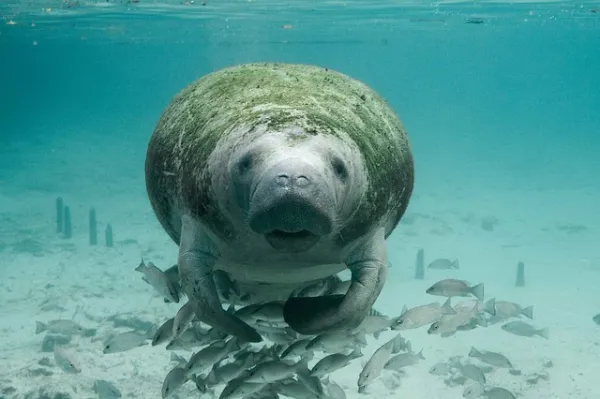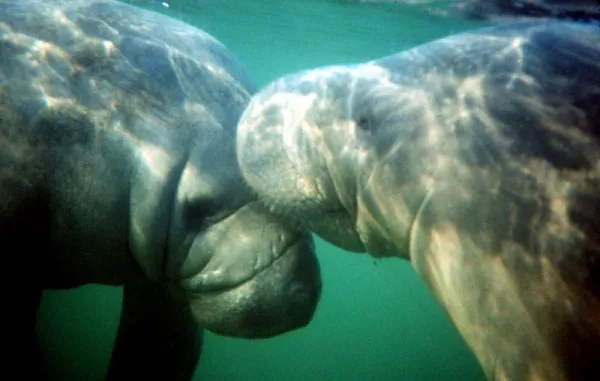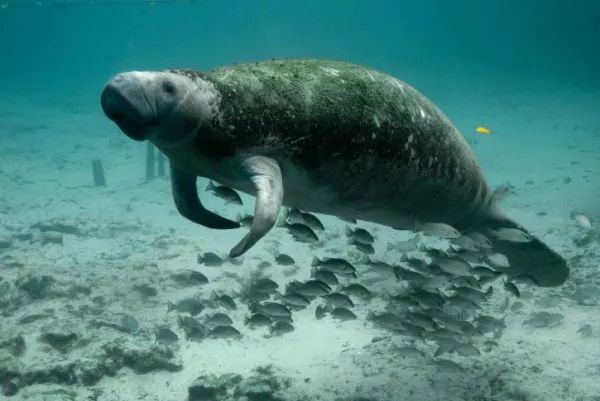Manatees (order Sirenia) are large, gentle herbivores of tropical and subtropical coasts, estuaries, and—depending on the species—rivers and lakes. Often nicknamed “sea cows,” they are ecosystem engineers for seagrass meadows and river–estuary wetlands. Yet habitat loss, human disturbance, and compounding environmental stressors are pushing many populations toward the brink.

Manatee basics
Living manatee species
Manatee vs. dugong: how to tell them apart
Why Manatees-Are-Endangered.html">manatees are endangered: main threats
What we can do: protection & actions
Size & build: Adults reach 2.5–4 m in length and 300–600+ kg. Bodies are cylindrical with paddle-like foreflippers and a broad, rounded tail.
Habitats: Favor warm, shallow, clear waters—seagrass beds, mangroves, coral-reef margins, lagoons, deltas; some populations live in freshwater rivers and lakes.
Diet & ecological role: Strictly herbivorous, grazing seagrasses and aquatic plants. Continuous grazing keeps seagrass meadows healthy, recycles nutrients, and shapes habitat for other species.
Life history: Slow to mature (≈3–10 years). Gestation 12–14 months. Typically 1 calf per pregnancy. Calves nurse 1–2 years. Low reproductive rate makes population recovery slow.
Indicator of ecosystem health: Highly sensitive to water temperature, oxygen, pollution, and plant quality. Their condition mirrors the health of nearshore ecosystems.

West Indian (Caribbean/Florida) manatee (Trichechus manatus)
Occurs around the Caribbean, Gulf of Mexico, and Florida, also along parts of the northern South American coast in brackish to freshwater habitats.
West African manatee (Trichechus senegalensis)
Found along the West African coast and rivers from the Senegal River to Angola’s Cuanza River, using estuaries and inland waters.
Amazonian manatee (Trichechus inunguis)
A fully freshwater species living throughout the Amazon Basin; the smallest of the Manatees-Are-Endangered.html">manatees.
All three are in family Trichechidae and, together with the dugong, belong to order Sirenia.
Tail shape: Manatee = broad, rounded paddle; dugong (Dugong dugon) = dolphin-like, notched tail fluke.
Muzzle & feeding: Dugong’s muzzle projects downward, specialized for uprooting seagrass; manatees have a more rounded, clipping bite.
Skin & teeth: Dugong skin is typically smoother; manatees show continuous molar replacement (“molar marching”) adapted to abrasive plant diets.
Habitat use: Dugongs are almost entirely marine and seagrass-dependent; manatees range from marine to estuarine to freshwater (species- and region-dependent).
Lifespan: Dugongs can reach ~70 years; manatee reports commonly ~40–60 years (regional variation).

Status varies from Vulnerable (VU) to Endangered (EN) depending on region. The pressures below differ in intensity by area but show a consistent global pattern.
Coastal development: Housing, resorts, ports, dredging, and land reclamation alter hydrodynamics and remove seagrass beds.
Water infrastructure: Dams, gates, and channelization change flow, salinity, and seasonal water levels, disrupting warm refuges and foraging sites.
Seagrass die-offs: Turbidity, eutrophication, and sediment resuspension reduce light penetration, collapsing meadows and cutting food supply.
Manatees cruise slowly in shallow water and surface to breathe, making them highly vulnerable to collisions and propeller lacerations—a leading adult mortality factor in some regions.
Gillnets, longlines, crab traps, and lost “ghost gear” cause entanglement, wounds, starvation, or drowning.
Urban sewage, agricultural runoff, and industrial effluents drive eutrophication, hypoxia, and toxic algal blooms (e.g., red tides), leading to acute poisonings and chronic immune/reproductive impacts.
Manatees are cold-sensitive (stress often rises below ~20 °C). Winter cold snaps cluster animals at warm springs or power-plant discharges, creating risks of crowding, disease spread, and dependency on thermal effluents.
Storms, floods, and droughts reshape seagrass beds, salinity, and freshwater pulses; drought can trigger salinity spikes and food bottlenecks.
Floating invaders (e.g., water hyacinth) shade out seagrass and cause hypoxia; pathogens and parasites spread more readily in disturbed waters.
Unregulated tour boats, close approaches, touching, and feeding alter behavior and increase injury/infection risks.
Past exploitation for meat, oil, and hides severely reduced numbers; despite protections, illegal takes still occur in some areas.
Protect critical habitats: Seagrass meadows, mangroves, warm-water refuges, and migration corridors.
Smart coastal-zone management: Limit dredging/reclamation, control turbidity and nutrient inputs, restore seagrass and wetlands.
Speed zones & buffers: Slow-speed areas and no-entry zones in manatee hotspots; promote propeller guards and designated slow channels.
Gear innovation & recovery: Anti-entanglement designs, routine ghost-gear retrieval, and clear reporting/recovery programs at ports.
Monitoring & rescue: Rapid response for strandings/injuries, long-term population and health monitoring (including toxins, physiology, genetics).
Education & co-management: Engage fishers, boaters, and tourism operators with “view but don’t disturb or feed” guidelines.
Watch responsibly: Keep distance; do not chase, touch, or feed; minimize noise and wake.
Cut plastics & clean up: Join shoreline/underwater cleanups; reduce single-use plastics and discarded lines.
Support habitat restoration: Volunteer or donate to seagrass and mangrove restoration.
Reduce nutrient loads: Use fewer fertilizers and choose reef-safe sunscreens; conserve water and energy.
Report distressed animals: If you see an injured, entangled, or stranded manatee, call local wildlife authorities immediately—do not pull lines or push animals yourself.
By slowly and steadily grazing, manatees maintain the delicate balance of seagrass–estuary–nearshore ecosystems. Their slow reproduction and high environmental sensitivity mean that habitat damage, boat strikes, pollution, and extreme weather can rapidly depress populations. Protecting key habitats, reducing human pressures, and strengthening rescue and monitoring—with broad public participation—are essential if manatees are to move away from the edge of extinction and continue quietly “pasturing” the coastal shallows.
animal tags: manatees
We created this article in conjunction with AI technology, then made sure it was fact-checked and edited by a Animals Top editor.